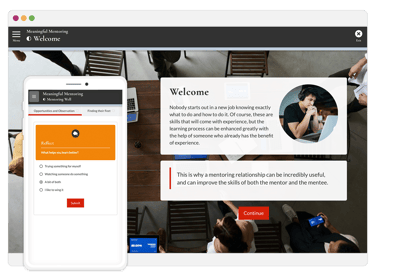Tired of having your employees complete training they don’t find helpful? Or, if you’re the employee, are you tired of completing training that doesn’t directly transfer into your everyday work environment? This is where incorporating a learning action plan comes into play.
What is a Learning Action Plan?
A learning action plan is a plan completed by the learner as part of their training. It establishes their goals for how they will apply their newfound skills or capabilities. A learning action plan is instrumental in supporting the learner in preserving and practising their knowledge after completing their training. Action plans can also encourage interaction between co-workers and their supervisors or managers through peer-to-peer activities to cement learning in the workplace setting.
Let’s look closer at how the action plan encourages learners to apply their learning in the workplace.
Contextualise the learning
Action plans can take the form of a written workbook that learners use to track their progress during and after completing their online, face-to-face, or blending learning sessions.
Let’s look at an example of an action plan activity prescribed to a learner who has participated in a face to face customer service program:
“Reflect on your most recent customer service experience. Did you receive any feedback from the customer? In what ways could you improve on your customer service skills, and how would this improvement benefit your organisation?”
In this example, the learner is prompted to consider the impact of their customer service training and skills on their wider organisation. Learners can share their responses with their colleagues to incite a discussion.
Help Learners Preserve their Knowledge Over Time
Insufficient learning transfer can cause corporate training programs to be ineffective in achieving the intended behavioural change. A learning action plan can counteract this risk as the learner reflects on their individual goals at regular intervals after completing their training module or session.
For example, learners may be encouraged to answer reflective-style questions at different stages, so their learning still resonates over time.
Let’s look at an example where the learner reflects on their goal-setting practices over time to determine whether their goals were realistic or not.
During the training:
"Record three short-term goals you wish to implement over the next three months. Also, consider three long-term goals you wish to implement over the next six months."
Three months after the training:
"On a scale from 1 to 10, how successful have you been in achieving your set goals? What are the reasons behind your level of success? What steps will you take to reach your goals over the next three months?"
Six months after the training:
"Reflect on your professional development over the past six months. Write down three ways you feel you’ve grown in your role. On a scale from 1 to 10, how successful have you been in achieving your long-term goals? What steps will you take to continue to develop?"
Learners should preferably share their thoughts with their supervisor to review the implementation of their skills in the workplace. Supervisors can use follow-up emails to notify the learner when it’s time to update their action plan and check on their goals.

Increase Employee Interaction with Co-workers, Supervisors and Managers
Action plans encourage employees to interact with their co-workers through peer-to-peer training initiatives to strengthen their skills.
An example of a collaborative activity in the action plan could be a role-play activity. In the case of the customer service training, it could be as follow:
"Have a colleague play the role of a customer who approached you with a common concern. While you interact with the ‘customer’, have another colleague observe and provide feedback on your performance. How did you feel the exercise went? What feedback did you receive from your colleague? Record it and share the notes with your supervisor to discuss the results."
Collaborative exercises with colleagues allow the learner to receive feedback from peers and superiors. It also helps them apply their learning in the environment it will ultimately be used, rather than limit practice to the allocated training day.
As such, action plans are essential for organisations and their employees to gain the most value from their learning over an extended period of time.


